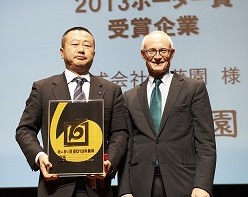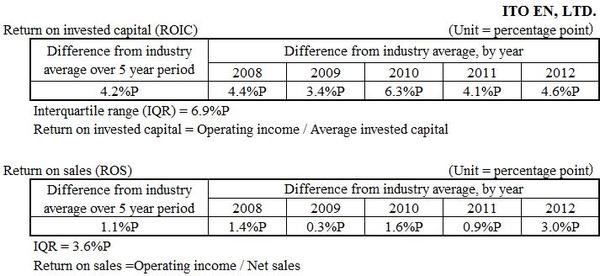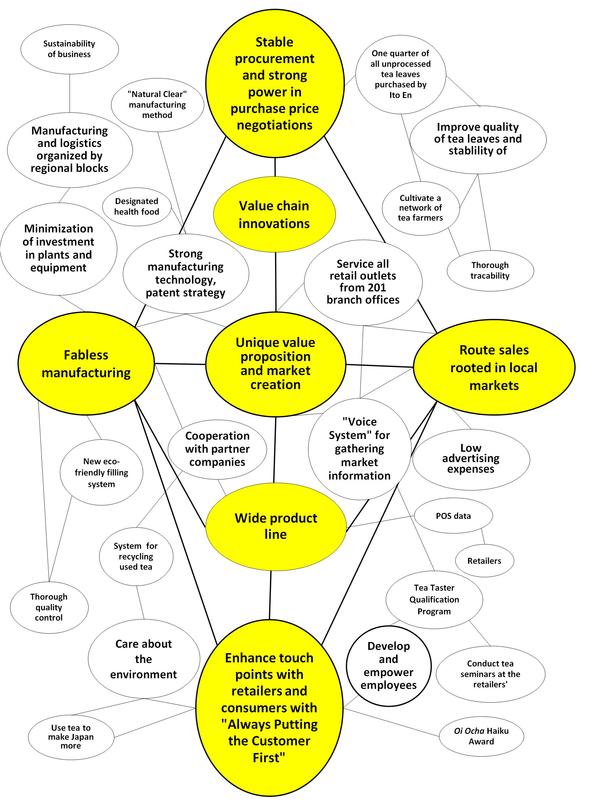Winners / Selection Rationale
ITO EN, LTD.
2013 13th Porter Prize Winner Tea leaf and beverage manufacturer and distributor
ITO EN has created a sugar-free drink market in Japan by focusing on green tea drinks in cans and PET bottles. It has a unique value chain, strengthened by a comprehensive product line of green tea drinks, a route sales system, and a tea-producing region development project.
Industry background
 The Japanese soft drink market has been growing because of increasing health consciousness and frequent heat waves during the summers. Meanwhile, competition in the industry has been intensifying, and price competition has become more prevalent as a result of the protracted economic slump and reduced spending by budget-minded consumers. The Japanese green tea drink market, which peaked in 2005, has been shrinking until the recent recovery. It reached 383 billion yen in 2012 (according to ITO EN's Performance Report for the fiscal year ended April 30, 2013).
The Japanese soft drink market has been growing because of increasing health consciousness and frequent heat waves during the summers. Meanwhile, competition in the industry has been intensifying, and price competition has become more prevalent as a result of the protracted economic slump and reduced spending by budget-minded consumers. The Japanese green tea drink market, which peaked in 2005, has been shrinking until the recent recovery. It reached 383 billion yen in 2012 (according to ITO EN's Performance Report for the fiscal year ended April 30, 2013). ITO EN is a unique beverage company that focuses on drinks made mostly of natural ingredients. It does not include alcoholic beverages in its product line. Out of the company's 5,307 employees, 4,000 are sales staff, mostly assigned to 201 local sales offices. Sales staff members introduce the products which they regard as most appropriate for each retailer, selected from the company's comprehensive product line. They also make efforts to understand customers' needs. The R&D department, which specializes in tea blending and manufacturing, strives to meet those customer needs through its product development activities. Partner factories scattered across Japan manufacture ITO EN's products, leveraging their unique competencies. ITO EN makes it a priority to help Japanese tea farmers improve their productivity. As a result, ITO EN can enjoy a stable supply of high-quality tea leaves. The company holds a 37% share of the green tea drinks market in Japan, and accounts for a 45% share among the top seven manufacturers, according to ITO EN's Performance Report for the fiscal year ended April 30, 2013.
Unique Value Proposition:
ITO EN's value proposition is natural, healthy, safe and tasty drinks (and tea leaves). Its target customers are individuals who want natural, healthy and safe drinks, and this customer segment is broad in terms of ages and genders. ITO EN's product line consists of drinks that are made primarily from natural ingredients, such as Japanese Tea Beverages Oi Ocha, Kenkou Mineral Mugicha (healthy mineral barley tea), Chinese Tea Beverages Oolong Tea, Vegetable Beverages Jujitsu Yasai (Vegetables Galore) and Ichinichibun no Yasai (A Day's Worth of Vegetables), Fruit Beverages Vitamin Fruit, Coffee Beverages Tully's Coffee, Black Tea Beverages TEAS' TEA, and Mineral Water evian. Sales of the products in these product categories accounted for 84.4% of the company's total sales in the fiscal year ended April 30, 2013. Other products include the Functional Beverages Kurozu to Moromisu (black vinegar and unrefined sake vinegar), Lactic Acid Bacterium Beverages, Sports Drinks, Carbonated Beverages, Food Beverages, and Tea Leaves. The company does not have alcoholic beverages in its product line. It has the broadest product line in the green tea beverages segment, which includes a variety of products sold under the Oi Ocha brand -- Oi Ocha Ryokucha (Green Tea), Oi Ocha Koi Aji (Dark), Oi Ocha Hojicha (Roasted Green Tea), Oi Ocha Genmaicha (Green Tea with Roasted Brown Rice), and Oi Ocha Zokkon (Cherished Blend). These products are available in different types of containers, such as cans, paper cartons, PET bottles, and hot-fill PET bottles, and in different sizes (2 liters, 500 milliliters, 200 milliliters, etc.).Soft drinks were often sold at a discounted price in supermarkets. Price competition extended to vending machines, which had been selling soft drinks at the manufacturer's suggested retail price for many years. ITO EN has been able to minimize the impact of price competition through the following means: First, it offers an extensive variety of products in the green tea segment, thereby meeting the specific needs of different retailers (i.e. small-sized cans for tiny shops operating in parks). Second, it places its products at a distance from other beverages. For example, it provides convenience store chains with heated cases (enabling the sale of warm drinks), and these cases are placed next to cash registers. Consequently, ITO EN's products can avoid head-to-head competition with the products of competitors. Third, a successful branding strategy allows the company to keep its prices at a higher level. In the case of coffee drinks, for example, ITO EN has leveraged the brand equity of Tully's Coffee Shops by introducing a Tully's brand can of coffee that sold for 130 yen at a time when competitors were charging 120 yen. ITO EN has been able to keep its price at 130 yen.
Unique Value Chain:
ITO EN's value chain is unique in terms of its procurement, product development, manufacturing, marketing and sales functions, and the high degree of consistency across functions. Below, the company's value chain is explained focusing on green tea drinks, which account for nearly half of the company's total sales.Procurement: Green tea products account for 46.3% of ITO EN's total sales, and its main product brand, Oi Ocha, uses only domestically produced tea leaves. Consequentially, ITO EN handles one-fourth of all the unprocessed tea leaves produced in Japan. The company has strong bargaining power in the negotiation of the purchasing price because of its scale. Meanwhile, land area under cultivation for tea leaves has been declining in Japan. ITO EN has launched the Tea-Producing Region Development Project. This project is being undertaken in collaboration with farmers and local governments in Japan. Through this project, the company helps experienced and new farmers to improve their productivity by providing them with the know-how for using machinery and ICT in farming operations. It also signs contracts with participating farmers to buy all the tea leaves they produce. This project supported 863 hectares of land under cultivation (with the contract tea plantation area accounting for 542 hectares, and the new tea plantation area comprising 321 hectares) in fiscal year 2012. The 863 hectares covered by this project accounted for 13.2% of the total amount of unprocessed tea leaves the company procured in fiscal year 2012. As a result of this project, ITO EN can ensure a more stable supply of tea leaves that are higher in quality, while farmers can realize improved productivity.
Manufacturing: The roasting and blending of tea leaves is undertaken primarily at ITO EN's Sagara Plant in Shizuoka. The abstraction and bottling processes that follow are outsourced to bottlers (packers). By outsourcing these processes, ITO EN is able to minimize investment in plants and equipment, while maximizing the flexibility for making adjustments in the manufacturing volume to accommodate fluctuations in demand and for selecting manufacturers by their unique competencies and the innovations they have achieved amid intense competition.
Research & Development: ITO EN focuses its research activities on tea leaves and tea drinks, starting with basic research and extending to blending techniques and manufacturing technology, which are often patented. Not only has ITO EN's success in R&D enabled the company to offer a greater variety of products and packages, it has allowed ITO EN to become the first in the world to commercialize canned oolong tea drinks and canned green tea drinks. These achievements were made possible through manufacturing innovations, such as a technique for preventing the oxidation of tea in the can-filling process. The company also has a unique patenting strategy for green tea drinks.
ITO EN aggressively adopts technological innovations created by outside bottlers. Such innovations have resulted in hot-fill PET bottles (an industry-first) and a new filling system--a non-sterilant system that has a lower environmental impact and does not require the use of sterilizers.
ITO EN's R&D activities involve the recycling of used tea leaves. The company generates 49,000 tons of used tea leaves, which is as much as the waste that the city of Nagoya processes in one month. Most of the used tea leaves are used as fertilizer and fodder. However, it does not make economic sense in the case of used tea leaves sent from the bottlers located in the metropolitan areas, given the transportation and drying costs involved. Thus, ITO EN started working on the development of its Used Tea Leaves Recycling System in 2001. Now, the company recycles used tea leaves, and this recycled pulp is used in paper products, boarding, resins, and building materials, thereby eliminating the expensive process of drying. The cardboard boxes developed with Rengo (a leading packing company) include used tea leaves as a material. About 25 million of these cardboard boxes are produced a year. This volume is equivalent to a year's worth of cardboard cases for Oi Ocha, with one cardboard case containing 24 bottles (500 milliliters) of Oi Ocha.
Marketing & sales: To get its products onto store shelves, ITO EN relies less on advertising expenses and more on its own sales force. Four thousand salespeople--all of them full-time employees and most of them assigned to 201 local sales offices across the country--visit retailers to explain product features, sell, and deliver products. Each salesperson proposes a customized selection of products to retailers, taking into consideration the retailer's or vending machine's location (office buildings, street-facing locations, train stations, parks, tourist spots, factories, construction sites, nursery schools, schools, elderly homes, hospitals, and transportation facilities) and target customers (gender and age). They also try to understand emerging customer needs through direct communication with retailers and consumers. Information on market needs is collected through a proposal system--the "Voice System"--and is used in new product development.
Human resources management: ITO EN instills in its staff the understanding that each individual employee is responsible for conducting marketing. It has created an original program--the Tea Taster Qualification System--to give recognition to those employees with an extensive knowledge of tea. Out of a workforce of 5,300 employees, 1,460 employees hold some kind of qualification (four employees have achieved the first-level degree, seven the "jun" (quasi) first-level degree, 210 the second-level degree, and 1,239 the third-level degree.)
Fit among Activities
ITO EN's procurement capabilities have helped it to achieve access to a stable supply of high-quality tea leaves. It also effectively leverages its own internal competence in R&D and the manufacturing technology of the bottlers. These strengths support the company's comprehensive product line in the tea drinks product category. This comprehensive product line has been utilized by sales staff in route sales, who prepare customized lists of proposed merchandise for retailers, to meet local customer needs and preferences, and also to avoid price competition. The sales staff members involved in route sales also contribute to the idea generation process for new product development. (Please refer to ITO EN's activity system map, which appears at the end of this report.)Innovation that Enabled Strategy
- The world's first canned oolong tea (launched in 1981).
- The world's first canned green tea (launched in 1985).
- The industry's first hot beverages sold in PET bottles (introduced in 2000).
Trade-offs
- Does not have its own bottling facilities.
- Does not conduct animal experimentation.
- Does not include alcoholic beverages in its product line.
- Does not outsource route sales.
- Does not use any flavoring additives or fragrances in its green tea drinks.
Consistency of Strategy over Time
ITO EN's has been working to create new markets through technological innovation. Its predecessor, a tea leaf seller, created a market for tea leaves in supermarkets, which did not carry loose tea leaves, and succeeded in developing a new package with an aluminum coating that would keep the tea leaves dry. (The standard practice in those days was to measure out tea leaves and sell them by weight.) Next, ITO EN entered the ready-to-drink market with the introduction of the world's first canned oolong tea drink in 1981. In 1985, it launched the world's first canned green tea drink following the development of a manufacturing innovation that prevents oxidation during the can-filling process. This has created a market for sugar-free drinks in Japan. In 1990, it introduced the world's first green tea drink in a PET bottle. This was followed by the introduction of hot drinks in PET bottles in 2000. Route sales that supported these innovations from marketing and sales have been in use since 1968, when the company opened its first branch office in Yokohama.ITO EN has broadened its product lineup, adding black tea drinks, coffee drinks, vegetable and fruit drinks and mineral water products. Its value proposition, however, has remained unchanged--natural, healthy, safe and tasty drinks. The company's expansion of its product range is highly consistent with its route sales and the outsourcing of the manufacturing function to bottlers.
Profitability
Both return on invested capital and return on sales far exceed the industry average.
Activity System Map

Winners PDF
- 2013 Porter Prize Winners PDF (All of the award company in this year are published. )





